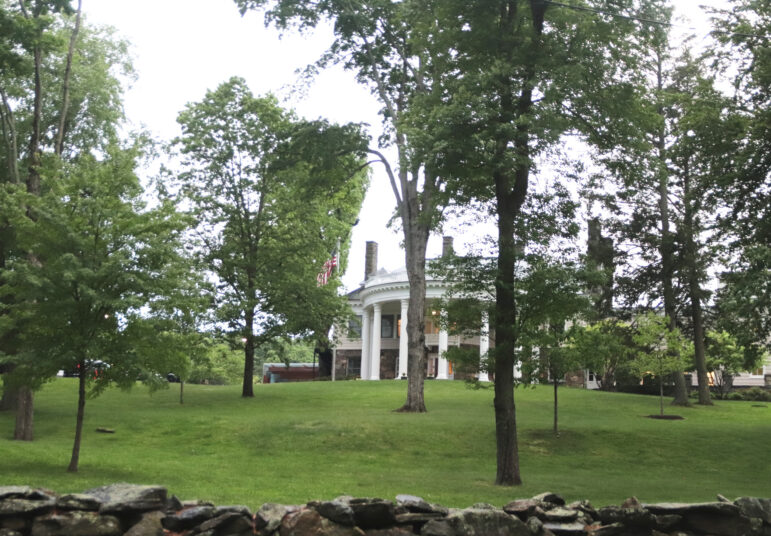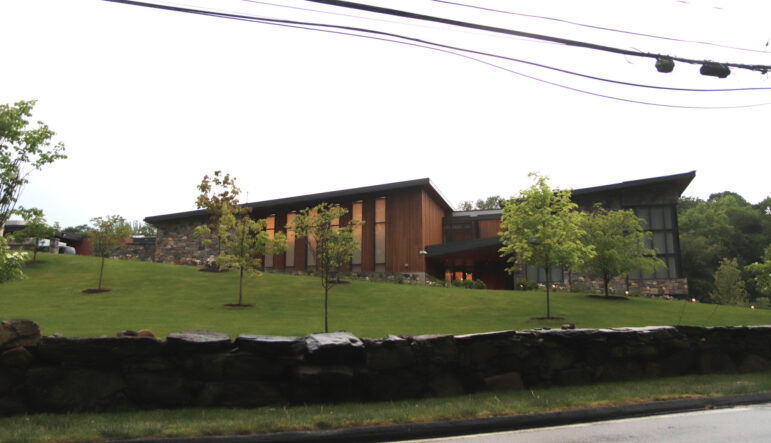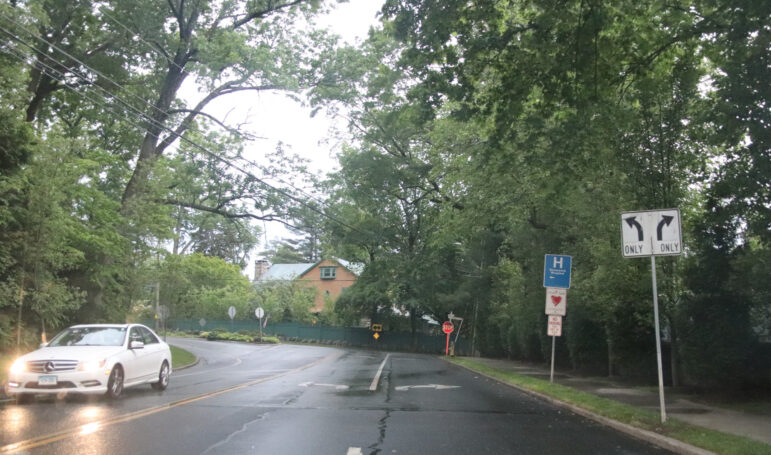At Tuesday’s Planning & Zoning commission meeting, the all-girls private school Greenwich Academy presented a pre-application and discussed an aggressive busing program for students, with an eye to alleviating local traffic and ultimately increasing the school’s enrollment by up to 100 students over the next four years.
Currently the school’s enrollment is capped at 730 students, plus or minus 2%. They operate on a 33-acre property located at 200 North Maple Ave.
Attorney Chip Haslun for the school noted the enrollment cap on the main campus was established 23 years ago.
In a letter to neighbors, Haslun stated that the school’s traffic flow had remained stable since the enrollment cap and that “traffic in general has increased from other sources and has had a negative impact on the intersection at North Maple Ave, Patterson Ave, and North Street, in particular.”
“It’s really traffic that was the issue at the time of putting the cap on the property,” Haslun said in his letter. “We recognize that will be the big issue, if we come in in the fall seeking relief from that cap from you and therefore we are working hard to come up with a trial busing plan for this fall.”


Purchase of Property on Glenville Road
Meanwhile, the school is the contract purchaser of the Indian Spring subdivision on Glenville Road. The school announced their intention to purchase that property in March and will potentially use it for athletic fields and staff housing.
Head of School Molly King, who is retiring this spring, explained that with the acquisition of the 54-acre Rockefeller property, Greenwich Academy could redeploy current athletic and arts spaces at the main campus.
Ms King provided the P&Z commission some context.
She said interest in the school had spiked during Covid from both local families and families from New York, and the demand had yet to diminish. Further, she noted fewer Greenwich students attend boarding school. She said that of the 65 students in 8th grade, only two are headed to boarding school for 9th grade.
She noted a potential lift of the enrollment cap would be consistent with significant recent growth of other local private schools, including Brunswick, the private school for boys and GCDS.
And, she said Greenwich Academy had a gap of 85 students in the upper school compared to Brunswick. Greenwich Academy girls share core academic classes – with the exception of math – with the senior boys from Brunswick.
Fall Busing Pilot Program
Today Greenwich Academy’s bus service is not included in the cost of tuition. The cost is significant, and a deterrent for some. The cost of the new busing program would be included in tuition.
Seniors are allowed to drive to school. Younger students are driven to school or pay for bus service.
Since so families transport their children by private car, increased bus ridership would dovetail with school’s focus on environmental sustainability.
Of course, during the pandemic families in both private and public schools were encouraged to drive their children to school rather than take the bus in order to increase social distancing.
Mr. Haslun said the school wanted to start the aggressive trial busing program under the current enrollment cap, with the goal of improving traffic flow on campus and in the surrounding neighborhood.
The program would start in the fall and be implemented with the assistance of the school’s traffic engineers, Kimley Horn.
Today the private school runs three bus routes along I95: Darien/Stamford, Bridgeport and the Bronx. Existing bus ridership is about 70 students. Of those, 45 are on Greenwich Academy buses and 35 are on town buses, with the largest ridership on town buses coming from Westchester.
Sixty-five percent of Greenwich Academy students live in Greenwich, but very few of them ride on the Greenwich school bus routes they’re entitled to because the district consolidated the routes making that option increasingly inconvenient.
With the new busing program the school would triple their bus routes from three to nine.
Greenwich Academy has been in conversations with Transportation Association of Greenwich (TAG,) a local non-profit.
“Our pick-up and drop-off times work very well for them with their existing schedule, and they are able to provide us with five 20-25-person buses for this purpose,” said Andrea Sabitsana, Chief Financial Officer for Greenwich Academy.
She said the shuttle bus effort would be for students in both the Greenwich area and a few key locations outside of town.
“We plan to focus on very convenient routes with shortened time frames with one to two stops each. Based on feedback from families, convenience is key, and we will not be making more than three stops per bus because it makes the pick up times too early for many families,” Sabitsana said.
The school surveyed their community and received over 320 responses, and more than 200 expressed a desire to ride the bus on several of the proposed stops.
Based on survey results the school planned to add stops in Old Greenwich, Riverside, Glenville, near Belle Haven and probably Stanwich Road, North Street, Rye and a location near the Merritt Parkway on the Stamford/New Canaan border. Most of the stops would probably be at church properties that don’t have traffic during these times.
Sabitsana talked about benefits of an aggressive busing program including sustainability, increased sense of community and convenience.
Mr. Haslun tied the busing back to the overarching goal of added enrollment.
“Hopefully in an amount that is sufficient for you to give us some relief to some number, which we don’t know of yet. We want to see what the data bears out after this initial trial busing program,” he said.
Commission Feedback and Neighbor Comments
The P&Z commissioners asked about level of service at key intersections.
“When you’re using buses, are you going to slow up traffic at intersections even though you have lower vehicle volume?” Alban asked.
Dennis Yeskey brought up the troublesome intersection of North Street, North Maple, Patterson and Maple, which is near the entrance of the school’s main campus.
“That is the weirdest intersection in Greenwich,” Yeskey said. “You’d hope there would be something that could be done. That would improve traffic and flow.”
Ms Alban suggested the commission contact Jim Michel of the Greenwich Dept of Public Works regarding the idea of improving the intersection.

During public comment, a neighbor, Karen Fassuliotis, said she supported reduction in traffic, but was not in favor of increasing enrollment.
“I worry about the enforcement of this plan going forward. I don’t see that the town or school really enforces things they put in place. I fear that with more students we’re going to have cars and more traffic.”
“A comment was made that traffic was not an issue with after school programs, and I can categorically say that that is not true,” Fassuliotis added. “Last night when I passed GA at 6:30, the campus was filled with cars to the point they were parked on the lawn and when they came out later that night it’s impossible to get through.”
Further she said, compared with Brunswick, “I don’t think you’ve been very good neighbors. I know I can go to Brunswick and give license plates of kids speeding through my neighborhood on Skylark, they respond very quickly.”
Fassuliotis said at the school’s recent graduation the streets were closed and neighbors were told they couldn’t get into their own houses on Hillside and told they shouldn’t be doing any gardening.
She said the schools should work with neighbors to minimize the impact on their lives.
“I understand you need to remain competitive with surrounding schools, but I fear that increasing the school by 100 kids to the campus will not be beneficial to the neighborhood overall,” she added. “I’ve seen deterioration in the quality of life.”
Barnett Osman disagreed. He said he lived directly across from the school’s entrance on North Maple and that Greenwich Academy was very considerate of neighbors, very communicative and were keeping the campus beautiful.
“They’re very conscious of when they use leaf blowers and landscaping, and are very conscious of neighbors,” he said, going on to describe the busing plan as “a no-brainer,” and better for the environment.
Mr. Osman said he anticipated that with athletics focused more at the Rockefeller property the overall noise level would also decrease on North Maple.
P&Z director Pat LaRow read aloud a letter from Nicole and Dan Negrea who said they were “vehemently opposed to the GA’s application to increase student enrollment.”
They said their house was on North Street at the intersection of Maple/Patterson/N Maple.
“Our intersection has quite heavy traffic for most of the day, but there are times when it is really heavy traffic, with a buildup of cars in many directions,” they said in the letter.
They wrote that the sound of car tires, engines, brakes, and especially honking, were already significant at peak times and unpleasant and they didn’t want them to increase.
They wrote that was difficult to get in and out of their driveway at peak times and that the noise from heavy car traffic was very loud and could be heard from inside their house even with the windows closed and locked.
At the end of the discussion, P&Z chair Alban said, “We understand your growth objectives, and yet our mandate is to try to protect the town and we’re trying to balance that.”
She said the school was invited to return any time in the fall to update the commission on the results of the busing program.